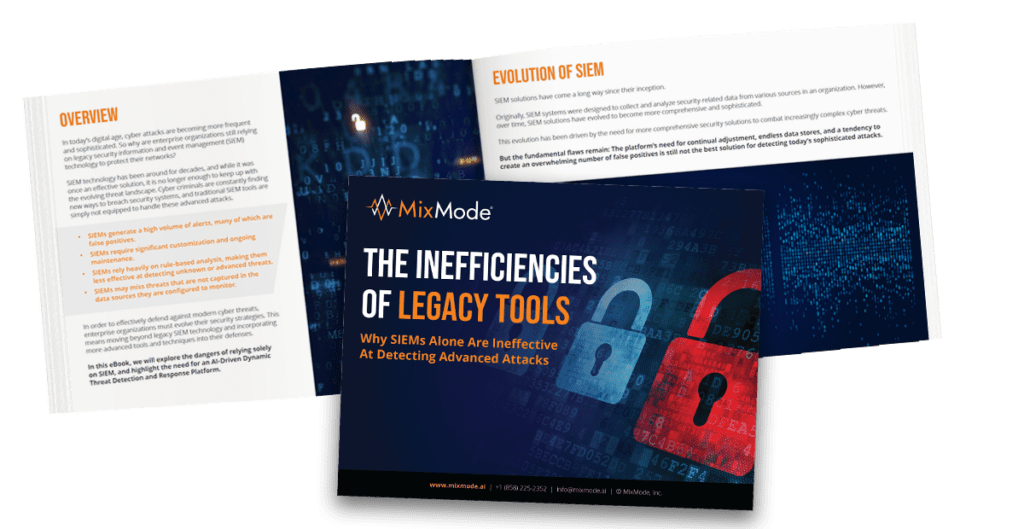
Relying solely on legacy Security Information and Event Management (SIEM) technology is no longer sufficient to protect enterprise organizations from the rising amount of modern, ai-developed, sophisticated cyberattacks. In our newest eBook, “The Inefficiencies of Legacy Tools: Why SIEMs Alone Are Ineffective At Detecting Advanced Attacks,” we examine the limitations of SIEMs and emphasize the need for an AI-driven dynamic threat detection and response platform.
Available for download today, key highlights from the eBook include:
Where SIEMs Fall Short
SIEM technology has been around for decades and has undergone several evolutions. However, despite these advancements, traditional SIEMs fall short in several crucial areas:
- Volume of Alerts: SIEMs generate a high volume of alerts, many of which turn out to be false positives. This flood of alerts overwhelms security teams and makes it harder to focus on real threats.
- Customization and Maintenance: SIEMs require significant customization and ongoing maintenance to adapt to an organization’s specific needs. This process can be time-consuming and resource-intensive.
- Rule-Based Analysis: SIEMs heavily rely on rule-based analysis, which makes them less effective at detecting unknown or advanced threats. Cybercriminals are constantly finding new ways to breach security systems, and SIEMs struggle to keep up with these evolving tactics.
- Limited Data Sources: SIEMs may miss threats that are not captured in the data sources they are configured to monitor. This limited visibility leaves organizations vulnerable to attacks that target user identities and abuse privileged access.
The Need for an AI-Driven Solution
To effectively defend against modern cyber threats, organizations must evolve their security strategies and move beyond legacy SIEM technology. The eBook emphasizes the importance of integrating more advanced tools and techniques into defenses, particularly those driven by artificial intelligence (AI). Here’s why:
- Handling Big Data: Traditional SIEMs struggle to handle the massive amounts of security event data generated by modern enterprise environments. This leads to longer processing times, missed events, and insufficient visibility into potential security threats. AI-driven solutions can effectively collect, analyze, and correlate data from multiple sources, enabling real-time threat detection and response.
- Real-Time Monitoring: SIEMs lack real-time monitoring capabilities, which can result in delayed detection and response to security incidents. Advanced threats such as zero-day attacks or advanced persistent threats require immediate action. AI-driven solutions provide real-time monitoring, ensuring timely detection and response to potential threats.
- Intelligence Integration: SIEMs often have limited integration with external threat intelligence feeds, making them less effective at identifying and countering developing threats. AI-driven solutions integrate threat intelligence, empowering security teams to proactively detect and respond to potential security threats before they cause harm.
- Reduced False Positives: Traditional SIEMs generate a high number of false positives, overwhelming security professionals and diverting their attention from real threats. AI-driven solutions leverage advanced analytics and machine learning to accurately distinguish between legitimate and malicious activity within the network, reducing false positives.
- Autonomous Defense: SIEMs heavily rely on human expertise for implementation, management, and analysis. AI-driven solutions, such as the MixMode Platform, autonomously learn, understand, adapt, and evolve without human intervention. This enables security teams to focus on critical threats, enhance overall defenses, and protect sensitive data.
How to Solve Today’s Threat Detection Challenges
In the face of evolving cyber threats, relying solely on legacy SIEM technology is no longer sufficient for organizations. Our eBook, “The Inefficiencies of Legacy Tools: Why SIEMs Alone Are Ineffective At Detecting Advanced Attacks,” highlights the limitations of SIEMs and emphasizes the need for an AI-driven dynamic threat detection and response platform. MixMode provides real-time monitoring, intelligent threat detection, reduced false positives, and autonomous defense capabilities.
To gain a deeper understanding of these challenges and explore effective solutions, we encourage you to download the full eBook today. Stay ahead of cybercriminals and protect your organization’s sensitive data with the power of Generative AI-driven cybersecurity.
This is the first in a series of eBooks diving into “The Inefficiencies of Legacy Tools.” Look out for our next installment soon!


